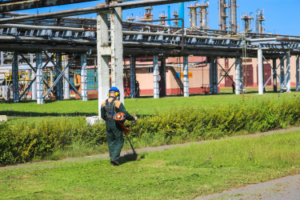If you’re an employer or landlord who owns a building or buildings, being aware of the dangers of legionella and how to test for it in your properties is vital. But what is legionella, and how do you test for it? In this article, we’re going to break down exactly what legionella is, who it’s harmful to, and how you can perform legionella water testing in your properties.
What is legionella?
Legionella is a type of bacteria that can cause a potentially fatal type of pneumonia called Legionnaires’ disease, as well as a less serious flu-like sickness called Pontiac fever.
The legionella bacteria can be found in naturally-occuring freshwater environments like lakes and streams, but can become a health concern if it reaches building water systems like:
- Shower heads and taps
- Water-powered air conditioners
- Hot water tanks and heaters
- Plumbing systems
- Hot tubs
- Fountains and water features
Where does Legionnaires’ disease come from?
Similar to the Covid-19 virus, Legionnaires’ disease infects people through airborne water droplets containing the Legionella bacteria, however it can’t be spread between people (so you cannot catch Legionnaires’ disease from someone who has it).
The best conditions for the legionella bacteria to grow include:
- Temperatures ranging from 20 to 45°C
- Stagnant water, or biofilm on the surface of the water
- Certain nutrients being present in the pipes and water systems of buildings; sediment, algae, scale, biofilm, rest, amongst others
- Poor preventative measures and lack of frequent legionella water testing
Who’s at risk of Legionnaires’ disease?
There were 254 confirmed cases of Legionnaires’ disease in the U.K. in 2020, however most healthy people who are exposed to legionella won’t suffer any symptoms or become ill. Those at an increased risk of getting sick include:
- Those who are 50 years old or older
- People who smoke or used to
- Those with a chronic lung disease
- People with weakened immune systems, or those who take drugs that weaken the immune system. For example, after chemotherapy or a transplant operation
- Those suffering with underlying illnesses like diabetes, kidney failure, or liver failure
- People with cancer
While the disease can be fatal to certain people, the legionella bacteria can be removed from water systems through correct maintenance. Employers and landlords have a legal duty to test and remove this bacteria from water systems in their buildings to protect the health of their tenants and employers.
What are my responsibilities as a landlord?
According to HSE “The legal duty for landlords who provide residential accommodation to consider, assess and control the risks of exposure to Legionella to their tenants”.
This means that all water systems in a building you own must have a risk assessment undertaken; this can either be done by yourself, or you can contact Dependable if you’re concerned about doing this. If a risk assessment is performed and demonstrates the risks of legionella being present are low, no further action is required but it is important to regularly review your systems in case anything changes.
How often do I need to test for legionella?
How often you perform a legionella water test will depend on the types of systems you have in your building, and the outcome of the initial risk assessment. HSE recommends that ‘open systems, such as cooling towers, evaporative condensers and spa pools etc, routine testing should be carried out at least quarterly’ whereas enclosed water systems are less prone to contamination and therefore do not need to be tested as frequently.
If a legionella risk assessment highlights the bacteria is present in your water systems, testing should be carried out every week until the bacteria is removed and the water system is safe for your tenants again.
How to test for legionella bacteria
There are three key methods of testing for the legionella bacteria in your buildings water systems:
- A PCR (polymerase chain reaction) test: This assessment only takes a few hours to complete, and is a fast and accurate way to detect for legionella, however tends to be more expensive due to the specialist equipment required.
- Lab-based testing: Water samples are collected from the buildings water systems and sent to a UKAS-accredited lab to identify if the bacteria can be found in the sample. However lab-based assessments can take up to two weeks before you’re sent results.
- Rapid-swab testing: Rapid swab-testing legionella kits can be purchased online, and can detect the legionella bacteria in as little as 25 minutes. Although rapid-swab tests can be a good initial indication, they should not be used as an alternative to robust water assessments, as only lab-based tests can detect a type of legionella bacteria known as Sero Group 1.
How can I prevent legionella bacteria in my building?
There are a number of simple preventative measures you can take to help control the risk of legionella exposure, including:
- Performing a full system-flush of water systems regularly
- Taking steps to avoid debris getting into systems (for example, ensuring water tanks have secure and tight fitting lids)
- Ensuring control parameters are set to minimise optimal legionella-growing environments (for example, setting the temperature of calorifiers to store water at 60°C, which is above the preferred conditions for legionella growth)
- Remove redundant pipework
If you’d like help checking your systems and plumbing, get in touch with us today, or you can find more information from HSE about legionella and Legionnaires’ disease here.
Recurring or unexpected plumbing issues can be a hazard for legionella growth, and troublesome for a busy landlord. If you need a one-off repair, or help with plumbing blockages and bursts, you can depend on Dependable.




